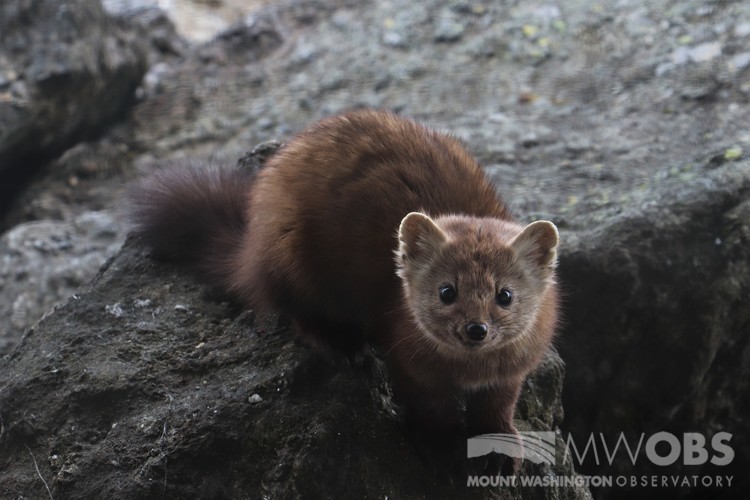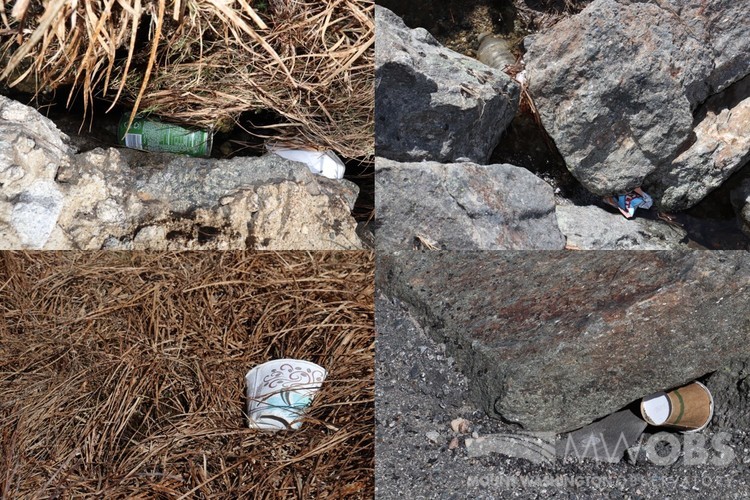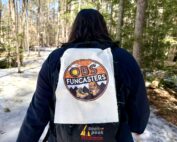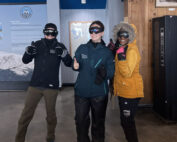Spring Cleaning and Spring Volunteers
2019-05-18 15:22:11.000 – Taylor Regan, Weather Observer/Research Specialist
Happy spring from the summit of Mount Washington! No, I know it’s not the first day of spring, but with nearly a week above freezing, things are finally starting to feel like we’re heading away from winter, if only a little behind the rest of the region. I wanted to take a few moments and talk about what spring looks like up here in the alpine zone, because there’s a lot going on!
It starts with the visitors. As the snows melt and conditions become slightly more hospitable, small rodents and birds come from all around to visit New England’s tallest peak. Juncos, voles, and all other manner of small creatures head for the summit. Bigger animals learn this behavior, and head up to visit too! Below is a picture of a pine marten that stopped by this week. Though this one looks cute and fluffy, these mustelids (of the weasel family) are voracious hunters, and have even been known to hunt rabbits! Yikes!

Figure 1. A marten on its best behavior grins at the prospect of summer!
These animals aren’t the only “creatures” to head to Mt. Washington as the weather turns more pleasant. With warmer and longer days, spring skiers arrive, hitting the slopes and the trails with enthusiasm, and seizing any opportunity to get in a few last runs before the sun melts away the winter snowpack.
Figure 2. Spring skiers, can you spot them?
There are other signs of spring too. With the Mt. Washington Auto Road finishing the clearing of the road, more work vehicles can make the trek to the summit, and get the building and surrounding areas ready for summer visitors. This includes the installation of many signs, such as the one below, informing visitors about the best ways to keep your car in good shape while driving the road!
Figure 3. Auto road signs.
The spring brings other signs of change as well. As the snowpack melts, lost things become found again, including this hat! (Image below) This spring alone, I’ve spotted two pairs of goggles, three hats, and several in-tact granola bars (in wrappers), just to name a few.
Figure 4. Anybody missing a hat?
Sadly, I’ve also spotted other things emerging from the snow as well. Wrappers, water bottles, coffee cups, orange peels. For a remote alpine peak, there sure is a lot of trash up here. The point here isn’t to shame those who litter… well, maybe a little bit. But, we understand it’s a windy place, and things often blow away and out of sight. It’s happened to us all!

Figure 5. Trash, trash everywhere.
No, instead, I just wanted to voice a proposition. This summit is a truly amazing place. It is home to a variety of wildlife and plant-life, some of which can only be found right here on the summit and surrounding peaks! These rare species have adapted to an incredibly harsh and unforgiving climate. They don’t need any more obstacles in their way, like coffee cups or discarded sandwich bags. Even orange peels or other discarded “compostable” items can be detrimental up here as well. Our annual average temperature is only 27 degrees, so things don’t decompose as fast as they would at lower elevations. This means that they either pollute the summit for a much longer time, or find their way into the diets of the birds and animals who visit the summit, which isn’t great for their digestive systems. So here’s what I’m asking: If you head up to the summit this year, and spot any trash, pick it up! If you already do, summit staff and the plants and animals up here thank you. If you don’t, consider it! We only have one planet, and it’s full of some pretty amazing things. We can’t stop the wind from blowing things away up here, but we can pick things up when we find them!
Plants and animals do all they can to survive up here. Take a look below, a lone krummholz (miniaturized tree due to growing in harsh conditions) grows under the shelter of a large rock. It’s the only one I could spot up here, meaning it somehow won the lottery of sheltered spots that allowed it to receive enough sunlight and moisture, yet be sheltered enough from the winds to simply survive!
Figure 6. A lone krummholz.
Another thing I should mention, when recovering trash, or just simply exploring the summit, please don’t step on the mosses, sedges, or grasses up here! Doing so can harm the fragile plant-life, and further damage the intricately balanced ecosystem up here. Instead, stick to trails, or if you must (i.e. to get a piece of trash that has blown off the trail), rock hop! It can be a fun way to explore, and you can feel better about leaving less of an impact on the environment!
Below is an image of some moss just beginning to awaken from a long winter’s “nap.” Sunlight was just reaching the area where the moss is sheltered, and created stark contrast against the rocks. Pretty cool, right?
Figure 7. A sleepy patch of moss, just beginning to awaken from a winter “nap.”
Soon alpine flowers will be in bloom, and the auto road and railway will be open, ferrying thousands of visitors to this special place. We hope you come visit, and learn about not only the unique weather, but also the unique plants and animals that call this place home. And remember, if you do visit, you can help keep this place as amazing as it is, simply by picking up any trash that you see! Thanks!
Taylor Regan, Weather Observer/Research Specialist
Team Flags Return for Seek the Peak’s 25th Anniversary
Team Flags Return for Seek the Peak's 25th Anniversary By MWOBS Staff Mount Washington Observatory is looking forward to continuing a much-loved tradition for Seek the Peak’s 25th Anniversary: Team flags. In inviting teams
Meet Summer Interns Zakiya, Max and Maddie
Meet Summer Interns Zakiya, Max and Maddie By MWOBS Staff We are excited to welcome six teammates to the summit of Mount Washington this summer! During their internship, these students and graduates will play
Saying Goodbye to the Summit
Saying Goodbye to the Summit By Alexis George After an extraordinary last three years working as a Weather Observer and Meteorologist, I am excited to pursue a different career. As sad I as am




